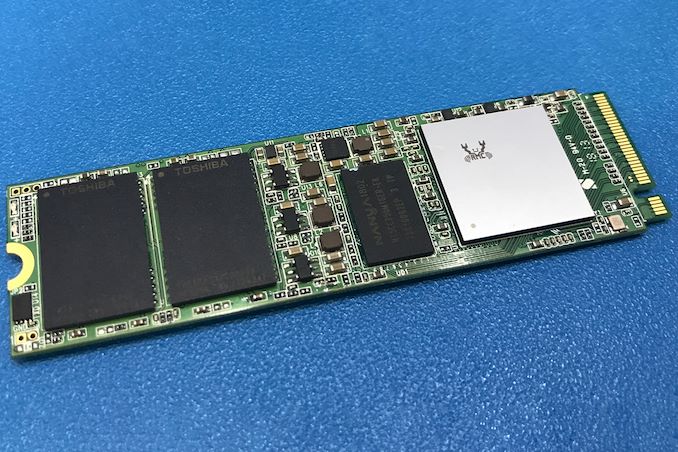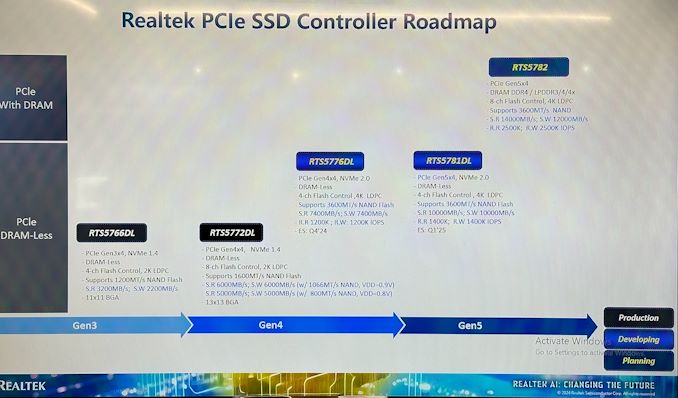Realtek Outlines SSD Controller Roadmap: High-End PCIe 5.0 x4 Platform in the Works
by Anton Shilov on June 13, 2024 12:00 PM EST- Posted in
- SSDs
- Storage
- Realtek
- Computex 2024

While Realtek is best known in the enthusiast space for for its peripheral controllers such as audio codecs and network controllers, the company also has a small-but-respectable SSD controller business that tends to fly under the radar due to its focus on entry-level and mainstream drives. But Realtek's stature in the SSD space is on the rise, as the company is not only planning new PCIe Gen5 SSD controllers, but also their first high-end, DRAM-equipped SSD controller.
For this year's Computex trade show, Realtek laid out a new SSD controller roadmap that calls for the company to release a trio of new SSD controllers over the next couple of years. First up is a new four-channel entry-level PCIe 4.0 controller, the RTS5776DL, which will be joined a bit later by a PCIe 5.0 variant, the RTS5781DL. But most interesting on Realtek's new roadmap is the final chip being planned: the eight-channel, DRAM-equipped RTS5782, which would be the company's first high-end SSD controller, capable of hitting sequential read rates as high as 14GB/second.
| Realtek NVMe SSD Controller Comparison | |||||||||
| RTS5782 | RTS5781DL | RTS5776DL | RTS5772DL | RTS5766DL | |||||
| Market Segment | High-End | Mainstream | Entry-Level | ||||||
| Error Correction | 4K LDPC | 2K LDPC | |||||||
| DRAM | DDR4, LPDDR4(X) | No | No | No | No | ||||
| Host Interface | PCIe 5.0 x4 | PCIe 5.0 x4 | PCIe 4.0 x4 | PCIe 4.0 x4 | PCIe 3.0 x4 | ||||
| NVMe Version | NVMe 2.0 | NVMe 2.0 | NVMe 2.0 | NVMe 1.4 | NVMe 1.4 | ||||
| NAND Channels, Interface Speed | 8 ch, 3600 MT/s |
4 ch, 3600 MT/s |
4 ch, 3600 MT/s |
8 ch, 1600 MT/s |
4 ch, 1200 MT/s |
||||
| Sequential Read | 14 GB/s | 10 GB/s | 7.4 GB/s | 6 GB/s | 3.2 GB/s | ||||
| Sequential Write | 12 GB/s | 10 GB/s | 7.4 GB/s | 6 GB/s | 2.2 GB/s | ||||
| 4KB Random Read IOPS | 2500k | 1400k | 1200k | - | - | ||||
| 4KB Random Write IOPS | 2500k | 1400k | 1200k | - | - | ||||
Diving a bit deeper into Realtek's roadmap, the RTS5776DL is traditional DRAM-less PCIe Gen4 x4 controller with four NAND channels, and is aimed at entry-level drives. The controller's NAND support is quite modern, however, supporting the latest ONFI/Toggle standards, which will allow it to hit NAND transfer rates up to 3600 MT/second. Across four channels, that's enough bandwidth to fully saturate a PCIe 4.0 x4 connection with sequential read/writes, while random 4K IOPS can burst as high as 1.2 million. Engineering samples of the controller are set to emerge in Q4 2024, so do not expect actual drives based on this chip to emerge for sale until the second half of next year at the earliest.
Realtek is also preparing the RTS5781DL, which can be thought of as a PCIe 5.0 version of their DRAM-less controller platform. The RTS5781DL features the same four-channel NAND layout and 3600 MT/sec max NAND transfer rates, which with the additional bandwidth afforded by PCIe 5.0, shifts the performance bottleneck back to the NAND. Overall, Realtek expects drives with its first PCIe Gen5 SSD controller to hit sustained transfer rates up to 10GB/second, and up to 1.4 million random read/write IOPS. The company aims to make engineering samples of this controller available in the first quarter of 2025, so actual drives will hit the market in late 2025 at best.
Finally, the pinnacle of Realtek's roadmap will be its RTS5782, which is the company's first high-end SSD controller. Besides including support for on-drive DRAM (DDR4/LPDDR4X) for higher performance, the back-end of the RTS5782 will feature an eight NAND channel design that supports transfer rates up to 3600 MT/second. Drives built with the controller are expected to be able to sustain 14GB/second sequential read rates and 12GB/second sequential writes, while the 4K random IOPS performance jumps to 2.5 million 4K read and write IOPS.
Unfortunately, the RTS5782 is also the farthest out of the three controllers, as it's still in the planning stages at Realtek. Consequently, for the moment the company isn't offering any guidance on when the new controller will be ready. No doubt the company will have more to show off next year for Computex 2025.











3 Comments
View All Comments
kpb321 - Thursday, June 13, 2024 - link
I have to imagine it will be a while before we see the PCI-E 4 controller paired with 3600 mt/s NAND. That is currently the top end so rarer and more expensive. Since the drive will be PCI-E interface limited in best case scenarios anyway I expect to see lots of drive with slower NAND. 2800 mt/s should be enough to still saturate the interface in best case situations. Not even sure if you'd see any impact in worst case scenarios since those probably aren't going to be NAND interface limited anyway.Marlin1975 - Monday, June 24, 2024 - link
I am more curious of their power usage and what nm they are made on.Seems a lot of these newer controllers run hot/use a lot of power that can have issues with sustained performance and/or longevity.
abufrejoval - Thursday, June 27, 2024 - link
I'm just totally fascinated that a company should go out there into what seems like a rather mature and saturated market and seemingly without any revolutionary vision or approach to SSD controllers as such, replicating a full range of products that have established competition at each point.And SSD controllers are very much about trust. You data and your business will survive audio glitches, a borked network packet will just retransmit, so cutting close quality corners is many of Realtek's established markets seems rather acceptable when the economy is there.
That's not the same with storage where trust needs to be earned over generations of products.
And then they compete with manufacturers who build their own flash, which has gone both ways over the last years, upping the competitiveness of the environment.
I wish them good luck but I doubt that I'd be one of the first to put a chip in their basket.